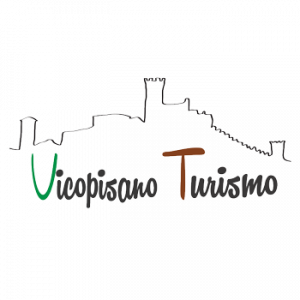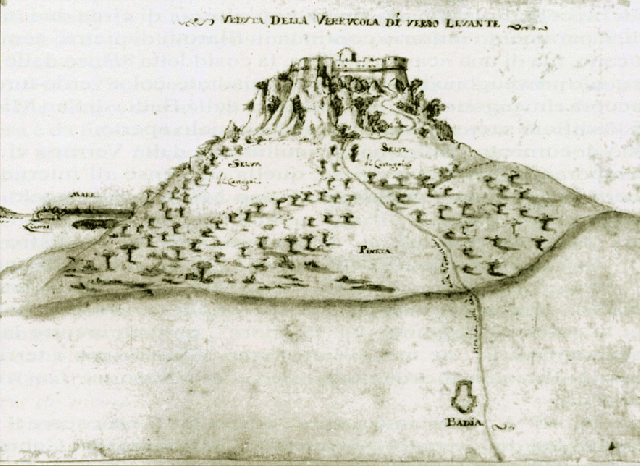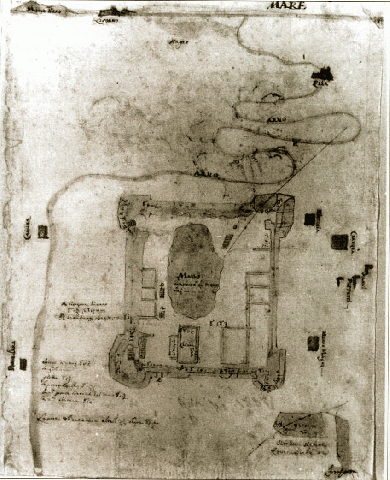Origins
Documentary researches do not indicate when the fortress was constructed, but they do show that the it certainly existed before the year 1000. In fact, the first mention of the castle of the Verruca is in a document dated 21st July 996 , the day in which Emperor Otto III confirmed to Majone, Abbot of San Salvatore di Sesto, all the assets previously owned by the abbey, including the Verruca “… Rocca etiam que dicitur Verruca … ” and the Abbey of San Michele alla Verruca.
Before that year, the nucleus was formed by two distinct settlements: the Rocca on top of the hill and the Church of St Michael Archangel at its base.
It is conceivable that a village developed soon around these important structures, which traces remain in later documents. Their bodies were visible at least until the beginning of our century.
Another important document is the one drawn up in Bamberg on 25th April 1020 by Emperor Henry II, confirming to Benedict Abbot of S. Salvatore di Sesto the possessions of the monastery and all its dependencies, among which the Rocca della Verruca,"Roccam quae dicitur Verruca". In 1192, a register of taxes of the Roman Church mentions the fortress "...et pro quodam campo juxta Rocam" when speaking of the Verruca Monastery.
Also, the imperial diploma of 12th June 1209 mentions both places that make up the Verruca residential complex and assigns the castle ” Verruca arcem “ to the custody of the Monastery, further reinforcing the link that existed between the fortress and the place of prayer. When Henry VII stayed in Pisa in 1313 and confirmed the Verruca castle to the Pisan Republic, he also named both sites " Monasterium Sancti Michaelis Archangeli situm infra Castellum, quod dicitur Verruca"” .
See also:
Verruca in the wars between Pisa and Florence
For the subsequent history of the site, it is appropriate to refer to the work of historians who, from Renaissance onward, have narrated the events of the war that took place around the Verruca. Three 16th-century writers, P. Giovo, S. Ammirato and L. Sfrenati, describe the facts happened around the Verruca, which was inevitably the protagonist of battles and sieges. We thus learn that the first time it fell into the Florentine hands was in 1404, following a betrayal by the lord of Pisa, Gabriello M. Visconti, who sold it to his enemies.
It was reconquered in 1431 by Niccolò Piccinino, a captain on the payroll of the Visconti's family of Milan: "il secondo giorno di primavera, Niccolò Piccinino comparve nel lucchese ed inoltrato nel pisano si impadronì di Asciano e di tutta la valle di Calci. Due giorni dopo ebbe la Verruca "; but in July on the same year the Florentine were able to reconquer the Rocca and hold it until 1494 when, thanks to the intervention of Charles VIII, the Pisan regained their freedom and reoccupied all the fortresses, including the Verruca.
Despite numerous attempts by the Florentine to regain it, including one in 1498 led by Paolo Vitelli, the wart remained a Pisan garrison until 1503 , when it fell under the assault of French troops led by the Captain of the King of France Jacques de Silly, Balì di Caen (mentioned in the sources as Balì d'Occan).
The Florentine, once again in possession of the fortress and well aware of its importance, decided to fortify it and entrusted the project to the most important military engineer of the time: Leonardo da Vinci.
In fact, Pier Francesco Tosinghi, commissioner of the Florentine camp at Pisa, writes “Lui stesso [Leonardo] e compagnia arrivò qui e gli mostrammo tutto e noi pensiamo che egli ami molto la Verruca essendo ben adatta al suo gusto… oltretutto disse che stava pensando di renderla inespugnabile, ma per ora era cosa da mettere da parte perchè il maggior bisogno è a Libafatta, la quale non è una piccola impresa da essere sottovalutata. Questa(la Verruca)dovrebbe essere riparata per fornire sufficente protezione e poi essere munita per il perfezionamento richiesto”. Leonardo returned to the Verruca in July 1503, a period in which he was working on his plans for the diversion of the Arno and certainly chose this place as a point of observation of the course of the river. The entire series of views of the Monti Pisani and the Pisa plain in the Madrid II codex can be dated to this period.
The importance of the Verruca can also be deduced from a letter written by Niccolò Machiavelli “…pensiamo che subito voi harete già pensato di andare avanti et levarvi dianzi ali ochi la Verrucola, la quale ci è sempre stata una continua molestia et uno impedimento ad codesti nostri luoghi all’intorno, et adiuto non picciolo alli inimici “.
Guicciardini had the same opinion when he wrote “è il sito della Verrucola, piccola fortezza fabbricata sopra un alto monte di molta importanza, perchè vicina a Pisa 5 miglia, non solo è opportuna ad infestare il paese circostante insino sulle porte di quella città, ma ancora a scoprire tutte le cavalcate e genti che n’escono.”
On 17th May 1504 Florence was informed that Antonio da Sangallo on his return from Ripafratta, "farà la via della Verruca per vedere se vi manca nulla “ ("it's going to follow the Verruca's path to see if there's lack of something"). Between July and August of the same year thirty "scarpellini" were sent to the Verruca, undoubtedly by decision of Sangallo, to complete the work begun as soon as possible.
Today, a careful examination of the surviving structures reveals this intervention in the drip line that runs along the entire perimeter of the fortress, a sign of an intervention carried out according to the most up-to-date techniques, albeit within the limits of a modest operation.







 comune vicopisano
comune vicopisano